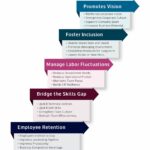In the rapidly evolving tech industry, it is essential to possess skills that are always in demand. These evergreen skills not only provide job security but also open up various opportunities for growth and advancement. Here are five such skills that will always be in high demand in the tech industry.
Key Takeaways
- Proficiency in programming languages such as Java, Python, and JavaScript is crucial for any tech professional.
- Cybersecurity skills, including network security, ethical hacking, and data privacy, are highly sought after to protect sensitive information.
- Cloud computing expertise, particularly in Amazon Web Services (AWS), Microsoft Azure, and Google Cloud Platform (GCP), is essential for businesses to scale and operate efficiently.
- Data analysis skills, including data visualization, machine learning, and statistical analysis, enable organizations to make informed decisions based on data-driven insights.
- User experience (UX) design skills, including user research, information architecture, and interaction design, are vital for creating intuitive and user-friendly digital products.
Programming Languages

Java
Java is a widely-used programming language that was first released in 1995. It is known for its versatility, as it can be used to develop a wide range of applications, from desktop software to mobile apps and web applications. Java is an object-oriented language, which means it focuses on creating reusable code components called objects. This makes it easier to maintain and update software projects over time. Java is also platform-independent, meaning that it can run on any operating system with a Java Virtual Machine (JVM). This makes it a popular choice for developing cross-platform applications.
Python
Python is a versatile and powerful programming language that has gained immense popularity in the tech industry. It is known for its simplicity and readability, making it an excellent choice for beginners and experienced developers alike.
One of the key strengths of Python is its extensive library ecosystem. The Python Package Index (PyPI) hosts thousands of open-source libraries that can be easily installed and used in Python projects. These libraries cover a wide range of domains, including data analysis, web development, machine learning, and more.
In addition to its libraries, Python also has a strong community of developers who actively contribute to its growth and development. This vibrant community provides support, shares knowledge, and collaborates on projects, making Python an ideal language for collaboration and learning.
Whether you’re interested in web development, data analysis, or artificial intelligence, Python is a language that can help you achieve your goals. Its versatility, readability, and extensive library ecosystem make it a valuable skill to have in the tech industry.
JavaScript
JavaScript is a versatile programming language that is widely used in web development. It is a high-level, interpreted language that allows developers to add interactivity and dynamic content to websites. JavaScript is supported by all major web browsers, making it an essential skill for front-end developers. With JavaScript, developers can create interactive forms, validate user input, manipulate HTML elements, and much more.
Cybersecurity

Network Security
Network security is a crucial aspect of cybersecurity. It involves implementing measures to protect computer networks from unauthorized access, misuse, and attacks. With the increasing reliance on technology and the internet, the demand for professionals skilled in network security is on the rise. Organizations need experts who can identify vulnerabilities, develop security protocols, and respond to incidents effectively.
One important aspect of network security is ensuring the confidentiality, integrity, and availability of data. This involves implementing encryption techniques, firewalls, and intrusion detection systems. Network security professionals also play a vital role in preventing and mitigating cyber threats such as malware, phishing attacks, and data breaches.
To excel in network security, professionals need to stay updated with the latest security trends, technologies, and best practices. Continuous learning and acquiring certifications like Certified Information Systems Security Professional (CISSP) can enhance their expertise and career prospects.
Ethical Hacking
Data privacy is a crucial aspect of ethical hacking. It involves protecting sensitive information from unauthorized access or disclosure. In today’s digital age, where data breaches and cyber attacks are becoming increasingly common, organizations are placing a high priority on data privacy.
To ensure data privacy, ethical hackers employ various techniques and tools. They conduct vulnerability assessments and penetration testing to identify weaknesses in a system’s security. By simulating real-world attacks, ethical hackers can uncover vulnerabilities and recommend measures to mitigate them.
One important aspect of data privacy is encryption. Encryption involves converting data into a format that can only be read by authorized individuals. This ensures that even if the data is intercepted, it remains unreadable to unauthorized parties.
In addition to encryption, organizations also implement access controls and authentication mechanisms to protect sensitive data. These measures ensure that only authorized individuals can access and modify the data.
It is important for organizations to prioritize data privacy and invest in robust security measures to safeguard their sensitive information.
To summarize, data privacy is a critical component of ethical hacking. It involves protecting sensitive information through techniques such as encryption, access controls, and authentication mechanisms.
Data Privacy
Data privacy is a crucial aspect of cybersecurity. It refers to the protection of sensitive information from unauthorized access, use, or disclosure. In today’s digital age, where data breaches and cyber threats are on the rise, ensuring data privacy has become more important than ever. Organizations need to implement robust security measures and adhere to privacy regulations to safeguard their customers’ personal and confidential data.
Cloud Computing

Amazon Web Services (AWS)
Amazon Web Services (AWS) is a leading cloud computing platform that offers a wide range of services and solutions for businesses of all sizes. With its scalable infrastructure and extensive suite of tools, AWS has become the go-to choice for organizations looking to leverage the power of the cloud.
One of the key advantages of AWS is its flexibility. It allows businesses to easily scale their resources up or down based on their needs, ensuring optimal performance and cost-efficiency. Whether it’s hosting websites, running applications, or storing and analyzing data, AWS provides a robust and reliable infrastructure that can handle even the most demanding workloads.
In addition to its infrastructure capabilities, AWS also offers a variety of specialized services. For example, AWS Lambda allows developers to run code without provisioning or managing servers, while Amazon S3 provides secure and durable object storage for a wide range of applications.
To help businesses get started with AWS, the platform provides extensive documentation, tutorials, and training resources. This ensures that users have the knowledge and skills to make the most of AWS’s capabilities and drive innovation within their organizations.
Overall, Amazon Web Services (AWS) is a powerful and versatile cloud computing platform that continues to be in high demand in the tech industry. Its scalability, reliability, and extensive suite of services make it an essential skill for professionals looking to stay competitive in today’s digital landscape.
Microsoft Azure
Microsoft Azure is a cloud computing platform and service provided by Microsoft. It offers a wide range of services and solutions for businesses and individuals to build, deploy, and manage applications and services through Microsoft-managed data centers. With its scalability, reliability, and global reach, Microsoft Azure has become one of the leading cloud platforms in the tech industry.
Google Cloud Platform (GCP)
Google Cloud Platform (GCP) is a suite of cloud computing services offered by Google. It provides a wide range of infrastructure and platform services that enable organizations to build, deploy, and scale applications and services on Google’s highly reliable and secure infrastructure. GCP offers a variety of services, including compute, storage, networking, and data analytics, as well as machine learning and artificial intelligence capabilities. With GCP, businesses can leverage the power of Google’s global network and data centers to run their applications and services efficiently and securely.
Data Analysis

Data Visualization
Data visualization is a crucial aspect of data analysis. It involves presenting data in a visual format, such as charts, graphs, and maps, to help users understand patterns, trends, and insights. By visualizing data, analysts can effectively communicate complex information and make it more accessible to a wider audience.
One common way to present structured, quantitative data is through a Markdown table. Tables provide a clear and organized representation of data, allowing users to compare and analyze information easily. When creating a table, it’s important to ensure it is succinct and formatted correctly in Markdown.
In addition to tables, bulleted or numbered lists can be used for presenting less structured content. Lists are useful for outlining steps, qualitative points, or a series of related items. They provide a concise and easy-to-read format that enhances readability and comprehension.
When working with data visualization, it’s essential to consider the audience and the purpose of the visualization. Design choices, such as color schemes, fonts, and layout, should be carefully selected to enhance the clarity and effectiveness of the visualization.
Remember, data visualization is not just about creating visually appealing charts and graphs. It’s about conveying information in a meaningful and impactful way that helps users gain insights and make informed decisions.
Machine Learning
Machine Learning is a rapidly growing field in the tech industry. It involves the development of algorithms and models that enable computers to learn from and make predictions or decisions based on data. Machine Learning is used in various applications, such as recommendation systems, fraud detection, and natural language processing.
One important aspect of Machine Learning is data preprocessing. Before training a model, it is crucial to clean and transform the data to ensure its quality and relevance. This process may involve handling missing values, normalizing features, and encoding categorical variables.
In addition to data preprocessing, feature selection is another key step in Machine Learning. Selecting the most relevant features can improve the performance and efficiency of the model. Techniques like correlation analysis, forward/backward selection, and regularization methods can be used for feature selection.
When evaluating Machine Learning models, it is important to consider metrics such as accuracy, precision, recall, and F1 score. These metrics provide insights into the model’s performance and can help in comparing different models.
Table:
| Algorithm | Description |
|---|---|
| Decision Tree | A tree-like model that makes decisions based on feature values |
| Random Forest | An ensemble of decision trees that improves prediction accuracy |
| Support Vector Machine | A model that separates data points into different classes using hyperplanes |
Machine Learning is a complex and evolving field, and staying updated with the latest techniques and algorithms is essential for success. Continuous learning, practice, and experimentation are key to mastering Machine Learning.
Statistical Analysis
Statistical analysis is a crucial skill in the tech industry, especially in the field of data analysis. It involves the collection, organization, and interpretation of data to uncover meaningful insights and patterns. Statistical modeling is used to make predictions and draw conclusions from data, helping businesses make informed decisions.
To effectively perform statistical analysis, professionals need to have a strong understanding of probability theory, hypothesis testing, and statistical software. They should also be proficient in data visualization techniques to present their findings in a clear and concise manner.
Here are some key concepts and techniques used in statistical analysis:
- Descriptive statistics: Summarizing and describing data using measures such as mean, median, and standard deviation.
- Inferential statistics: Making inferences and drawing conclusions about a population based on a sample.
- Regression analysis: Examining the relationship between variables and predicting outcomes.
In addition to technical skills, a successful statistical analyst should possess strong critical thinking and problem-solving abilities. They should be able to identify relevant data sources, design appropriate experiments, and communicate their findings effectively to both technical and non-technical stakeholders.
Tip: When performing statistical analysis, it’s important to ensure the data used is accurate, reliable, and representative of the population of interest. Additionally, it’s crucial to consider potential biases and limitations in the data collection process.
User Experience (UX) Design
User Research
User research is a crucial step in the user experience (UX) design process. It involves gathering insights and understanding the needs, behaviors, and preferences of the target users. By conducting user research, designers can make informed decisions and create user-centered designs.
User research methods can vary depending on the project and goals. Some common methods include:
- Surveys: Gathering quantitative data by asking users to answer a series of questions.
- Interviews: Conducting one-on-one or group interviews to gain qualitative insights.
- Observation: Watching users interact with a product or service to understand their behaviors and pain points.
By utilizing these research methods, designers can uncover valuable insights that inform the design process and lead to better user experiences.
Tip: When conducting user research, it’s important to ensure a diverse sample of users to capture a wide range of perspectives and needs.
Information Architecture
Information architecture is a crucial aspect of user experience (UX) design. It involves organizing and structuring information in a way that is intuitive and easy to navigate for users. Effective information architecture ensures that users can find the information they need quickly and efficiently.
One common approach to organizing information is through the use of hierarchical structures. This involves categorizing information into different levels of importance or relevance. For example, a website might have a main navigation menu with top-level categories, and each category can have subcategories.
Another important aspect of information architecture is labeling. Labels should be clear and descriptive, helping users understand what they can expect to find when they click on a link or button.
A well-designed information architecture can greatly enhance the user experience, making it easier for users to find what they’re looking for and navigate through a website or application.
Interaction Design
Interaction design is a crucial aspect of user experience (UX) design. It focuses on creating intuitive and engaging interfaces that allow users to interact seamlessly with digital products. Interaction designers use their expertise in psychology, human-computer interaction, and visual design to design interfaces that are both aesthetically pleasing and functional.
Key Principles of Interaction Design
- Affordance: The design should provide clear cues and visual indicators to users about how they can interact with the interface.
- Feedback: Users should receive immediate and informative feedback when they interact with the interface.
- Consistency: The design should follow established patterns and conventions to ensure a consistent user experience.
Interaction design plays a crucial role in creating user-friendly and intuitive digital experiences. By understanding user needs and behaviors, interaction designers can create interfaces that are easy to use and navigate.
Tip: When designing interactions, consider conducting user research and usability testing to gather insights and validate design decisions.
Conclusion
In conclusion, the tech industry is constantly evolving, but there are certain skills that will always be in demand. Adaptability is key, as technology continues to advance at a rapid pace. Problem-solving and critical thinking are also essential, as they enable professionals to find innovative solutions to complex challenges. Additionally, communication skills are crucial for effective collaboration and conveying technical concepts to non-technical stakeholders. Finally, a strong foundation in programming and coding is a fundamental skill that will always be in high demand. By honing these evergreen skills, individuals can position themselves for success in the dynamic and competitive tech industry.
Frequently Asked Questions
What are the most in-demand programming languages?
The most in-demand programming languages in the tech industry are Java, Python, and JavaScript.
What is cybersecurity?
Cybersecurity refers to the practice of protecting computer systems and networks from digital attacks, unauthorized access, and data breaches.
What are the main areas of cybersecurity?
The main areas of cybersecurity include network security, ethical hacking, and data privacy.
What is cloud computing?
Cloud computing is the delivery of computing services over the internet, including storage, databases, software, and networking.
What are some popular cloud computing platforms?
Some popular cloud computing platforms are Amazon Web Services (AWS), Microsoft Azure, and Google Cloud Platform (GCP).
What is data analysis?
Data analysis is the process of inspecting, cleaning, transforming, and modeling data to discover useful information, draw conclusions, and support decision-making.




